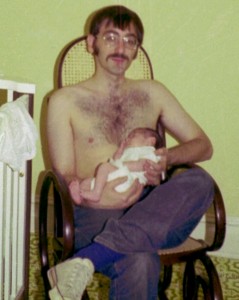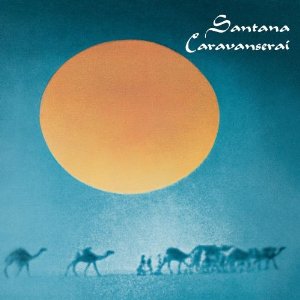Through the Heat
Theme Songs Page | Previous Theme Song | Next Theme Song
Through the Heat
Eternal Caravan of Reincarnation, by Michael Shrieve, Neal Schon & Tom Rutley, performed by Santana (1972), encountered 1975
In the summer of 1975, S. and I faced the necessity of moving: the one-bedroom student apartment in which we had lived for four years[1] was now going to be too small, as we were expecting a baby in September. While we’d hoped that the move would take us to some other college town now that I’d earned my doctorate, no university had picked up my option.
So the move was bound to be within Baltimore. We had both budgetary limitations and ideas about how we wanted to live our lives that militated jointly against doing what the in-laws would have like and moving to their suburbs. Our idea was to stay near the Johns Hopkins campus.
But it had to be a house now. And so we went looking in various dubious neighborhoods – for a couple of months, if memory serves. For the longest time we could find nothing affordable that wasn’t also grim. Eventually, I forget how, we discovered 3035 Guilford, little more than two blocks away, a rowhouse with three bedrooms and a semi-finished basement to work in as well. It wasn’t in bad shape, in fact, as I wrote at the time, “it is pleasant, airy, and gas-heated.” The price was right.
I wrote to my mom and stepdad on July 5 that we had the place (I assume I’d just inked the rental contract). And we moved in August. In between lay much making of arrangements and then the moving itself. And when I think of that time, there is always one image – except it’s not merely visual – that comes into view. In my mind’s eye, I’m walking that two-block long stretch of 31st Street in blistering, shimmering, soul-annihilating heat.
And instantly, the song that comes to my mind is Santana’s Eternal Caravan of Reincarnation. It’s an instrumental that starts with a generous helping of chirping-cricket sounds with a saxophone behind them (played by Hadley Caliman) making strange noises like some Mideastern horn. One is immediately transported to a desert oasis (crickets do live in deserts, among other places).[2] Then, at 1:45, comes swaying music marked off by a bass figure (Tom Rutley plucking away) followed 15 seconds later by a shimmering phased electric piano (Wendy Hass), making one almost see the vibration of the air with the mirage effect, and clearly we are contemplating the arrival of camels in caravan, just as the title suggests, through a desert haze. And although Carlos Santana does play some chords, the song from that point belongs to Hass and her shimmering piano.[3] Never have I heard a number that so vividly conveys sheer atmospheric heat.[4]
I may have been only myself, not a caravan, but that song is me, trudging through the blast of a Baltimore summer in that season of making ready for a change.

Santana had recorded it three years earlier, so you may ask why it had only just come to my attention in 1975. The answer: I had recently discovered that the Towson Public Library possessed a great, if somewhat idiosyncratic collection of pop, jazz, and rock LPs which you could borrow and capture on your reel-to-reel. The newest stuff tended to circulate more, meaning that there was more competition for it, and the older stuff, at the end of its physical lifespan, was more available. So if you didn’t mind your taped copy being full of pops and scratches, you could score amazing stuff. (My copy of the song today, however, is ripped from a CD.)
Walking through that heat to the new house, perhaps carrying something as a caravan would, I was clearly making progress, despite impediments, despite not finding a job, despite being turned down even by local prep schools for positions teaching high schoolers. I had finished my dissertation, and I was going to be a father. Those were big things.
And here is a photo taken a couple of months later in the new house, with my perfect little girl, still obviously coping with the heat.
[1] This was at 3120 St. Paul Street, a lovely place with a grand grassy courtyard in the middle, stucco walls, wide staircases and some family history attached. My stepdad had lived there when he was a grad student. (And my daughter, whose gestation is mentioned just below, lived there later on when she was a student at Hopkins.) The real estate agent who had located the place for us, a friend of S.’s parents, was one of those peculiar characters from an era ended only in 1948 in Baltimore, the time of restrictive covenants that had limited the residential opportunities for blacks and Jews, well delineated in Not in My Neighborhood, by Antero Pietila. The agent, being Jewish, had been involved in promotion of certain properties into which he himself could not have moved. His having run both with the hare and the hounds, as it were, had led to his being viewed with some resentment within his own community, including by my Jewish in-laws, but this resentment did not prevent them using his connection to land us a good place to live.
[2] I’d be willing to bet that the composers were taking a page from Pink Floyd’s Grantchester Meadows, released three years earlier, which opens with an extensive excerpt of birdsong.
[3] A very helpful note on the song is here.
[4] No, not Estate, not Something Cool, not Lazy Afternoon, not Too Darn Hot, not Summer in the City, not Under The Boardwalk or Up on the Roof. Not even the Body Heat theme.
Copyright (c) Jack L. B. Gohn, except for album artwork
